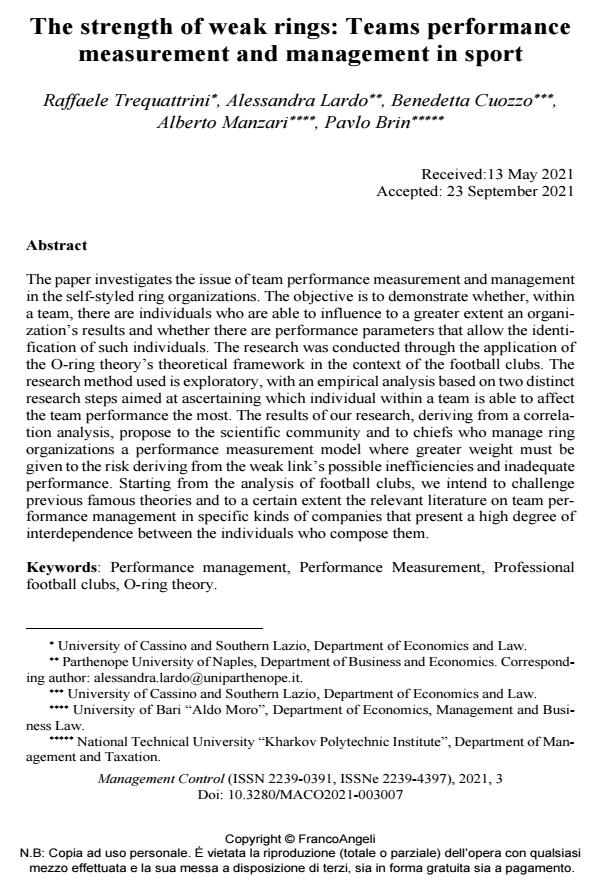The strength of weak rings: Teams performance measurement and management in sport
Titolo Rivista MANAGEMENT CONTROL
Autori/Curatori Raffaele Trequattrini, Alessandra Lardo, Benedetta Cuozzo, Alberto Manzari, Pavlo Brin
Anno di pubblicazione 2021 Fascicolo 2021/3
Lingua Inglese Numero pagine 17 P. 135-151 Dimensione file 214 KB
DOI 10.3280/MACO2021-003007
Il DOI è il codice a barre della proprietà intellettuale: per saperne di più
clicca qui
Qui sotto puoi vedere in anteprima la prima pagina di questo articolo.
Se questo articolo ti interessa, lo puoi acquistare (e scaricare in formato pdf) seguendo le facili indicazioni per acquistare il download credit. Acquista Download Credits per scaricare questo Articolo in formato PDF

FrancoAngeli è membro della Publishers International Linking Association, Inc (PILA)associazione indipendente e non profit per facilitare (attraverso i servizi tecnologici implementati da CrossRef.org) l’accesso degli studiosi ai contenuti digitali nelle pubblicazioni professionali e scientifiche
The paper investigates the issue of team performance measurement and man-agement in the self-styled ring organizations. The objective is to demonstrate whether, within a team, there are individuals who are able to influence to a greater extent an organization’s results and whether there are performance parameters that allow the identification of such individuals. The research was conducted through the application of the O-ring theory’s theoretical framework in the context of the football clubs. The research method used is exploratory, with an empirical analysis based on two distinct research steps aimed at ascertaining which individ-ual within a team is able to affect the team performance the most. The results of our research, deriving from a correlation analysis, propose to the scientific com-munity and to chiefs who manage ring organizations a performance measurement model where greater weight must be given to the risk deriving from the weak link’s possible inefficiencies and inadequate performance. Starting from the analysis of football clubs, we intend to challenge previous famous theories and to a certain extent the relevant literature on team performance management in specific kinds of companies that present a high degree of interdependence between the individu-als who compose them.
Parole chiave:Performance management, Performance Measurement, Professional football clubs, O-ring theory.
- Le dimensioni della conoscenza aziendale. Profili di investigazione tra crisi pandemica ed economia digitale Rosa Lombardi, in MANAGEMENT CONTROL 3/2021 pp.5
DOI: 10.3280/MACO2021-003001
Raffaele Trequattrini, Alessandra Lardo, Benedetta Cuozzo, Alberto Manzari, Pavlo Brin, The strength of weak rings: Teams performance measurement and management in sport in "MANAGEMENT CONTROL" 3/2021, pp 135-151, DOI: 10.3280/MACO2021-003007